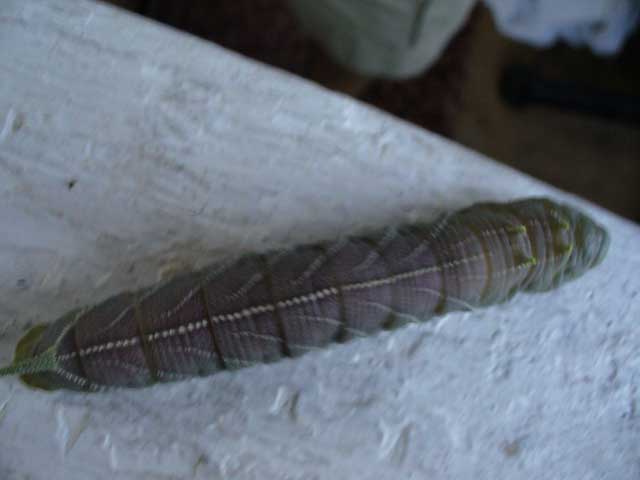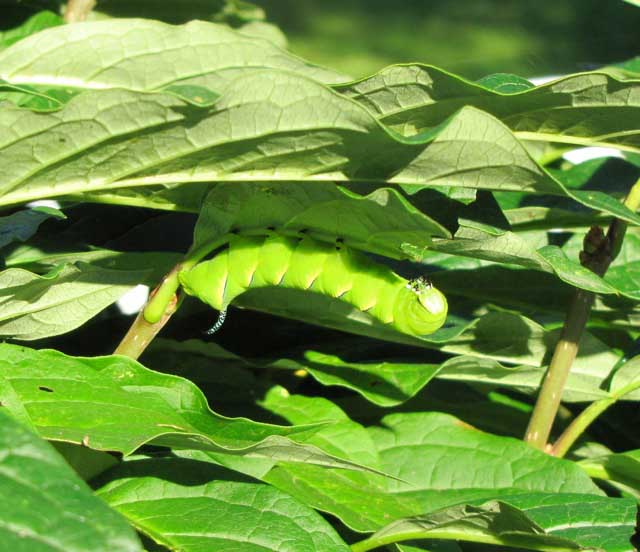Sphinginae subfamily
Sphingini tribe:
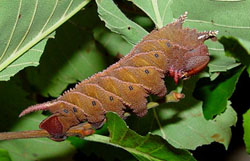 |
Ceratomia amyntor
common,
the Elm Sphinx or Four-horned Sphinx
Larvae feed on Elm (Ulmus), birch (Betula), basswood
(Tilia), and cherry (Prunus).
There are both green and brown forms. The four horns near
the head are diagnostic. |
 |
Fraxinus, Ligustrum, Quercus, Crataegus and
Chionanthus virginicus are listed as hosts.
In the fifth instar, the spiracular ovals are decidedly red and the
anal horn is off-white to pinkish laterally.
|
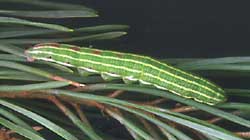 |
If you have pines, you probably have this species. It flies on P.E.I.
|
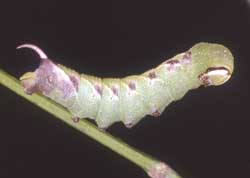
|
Sphinx canadensis
WO,
Sphinx canadensis, the Canadian Sphinx.
This species is not common at lights, and is not
often reported anywhere.
Larval host may be exclusively black ash (Fraxinus nigra).
Variable appearance but always with granulous (darker protrusions) on pinkish horn.
|
 |
Sphinx chersis
abundant, the Northern Ash Sphinx or
Great Ash SphinxThis species is present and is probably common.
Larval hosts are ash, lilac, privet, cherry, and quaking
aspen. Note pale blue horn.
|
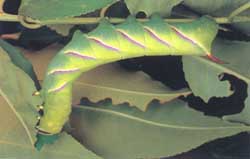 |
We have them
on P.E.I., but I do not see them nearly as frequently
as I see the other Sphingidae.
|
 |
The upperside of the forewing ranges from brown with black borders
through brownish gray with paler borders to pale gray with no
borders. It is probably Sphinx poecila that
is present in Ontario. |
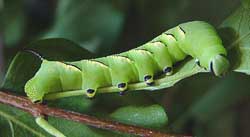 |
The lower forewings are predominantly brownish-yellow with a fairly
wide dark bar along the inner margin. At rest the wings hug the body,
giving the moth a long slender look. Anal horn is blue with extensive black markings in final instar.
|
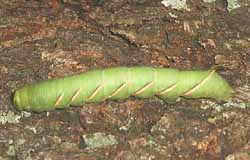 |
Sphinx luscitiosa
present,
the Canadian Sphinx or
Clemen's Sphinx
This one is reported from Ontario, but it is generally not common.
|
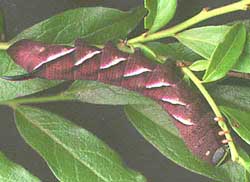 |
Sphinx poecila
abundant, the Poecila Sphinx
If you have blueberries in the woods, then you might have the
Poecila Sphinx.
They are pretty common here on Prince Edward Island. Larvae
can be purple or green.
|
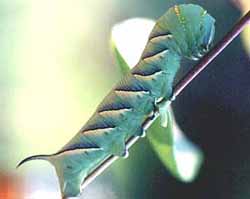 | Larvae feed on the common snowberry (Symphoricarpos albus)
and on coralberry (S. orbiculatus). Note the two golden lines
of slightly raised bumps, one just behind the head, the other on the thorax.
|
Smerinthini Tribe:
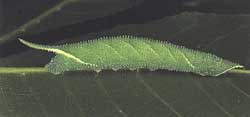 |
Amorpha juglandis larvae feed upon Walnut and butternut (Juglans),
hickory (Carya), alder (Alnus), beech (Fagus),
hazelnut (Corylus), and hop-hornbeam (Ostrya). |
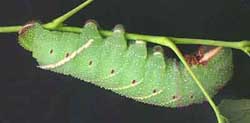 |
Larvae feed on poplars and cottonwood.
|
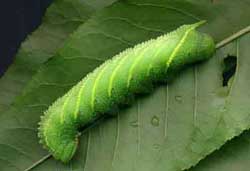 |
Larvae accept willows, birches, and cherries.
I have also found them in the wild on oak in eastern Canada. generally more eastern species |
 |
Named for the small eye-spot in the hindwing, this moth has a wide
distribution and is probably common in Ontario.
I regularly see them on Prince Edward Island, and they are reported
as far south as Florida.
|
 |
Smerinthus cerisyi,
the Cerisyi's Sphinx
Smerinthus cerisyi is found in the southern regions of all Canadian
provinces and in northern border states. The one-eyed sphinx is also
found along the U.S. west coast, eastward to the Rockies. At my home
in Montague, P.E.I., Canada, they are quite common.
|
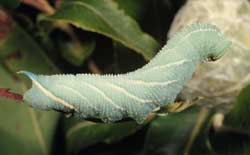 |
Larvae feed upon many forest trees including birches and cherries,
but are expecially fond of poplars and willows. Red markings on sides
vary greatly from specimen to specimen.
|
Macroglossinae subfamily
Dilophonotini tribe:
See Hemaris comparison to help distinguish
the next three species.
 |
There is also an orangey-pink prepupal form. The lateral line runs
from S1 to the blue horn.
Hemaris thysbe larvae feed on viburnum and related plants.
generally more eastern species
|
 |
Hemaris diffinis, the
Snowberry Clearwing or Bumblebee Moth
Larval host plants include Snowberry (Symphoricarpos),
honeysuckle (Lonicera), Coralberry, viburnums, Blue Dogbane
(Apocynum) and dwarf bush honeysuckle (Diervilla lonicera).
Horn is black with a yellow base.
|
 |
Hemaris gracilis, the
Slender Clearwing or Graceful Clearwing
This day-flying moth is less common.
|
Philampelini tribe:
 |
Eumorpha achemon
,
the Achemon Sphinx.
Larvae feed upon Grape (Vitis), Virginia Creeper
(Parthenocissus quinquefolia) and other vines and ivies
(Ampelopsis).
Mature (final instar) larvae occur in many colours: light green; tan/brown; orangey. Note six "segmented" oblique lines.
Immatures are often pinkish-red
with long, curved anal horns.
|
Macroglossini tribe:
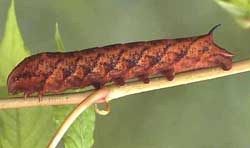 |
In additon to Virginia creeper larvae accept Grape (Vitis),
ampelopsis (Ampelopsis), and cayenne pepper (Capsicum).
Larvae are green until the final instar.
|
 |
Larvae feed on Azalea and Viburnum and progress very rapidly. The
larva to the left on Viburnum cassinoides is getting ready to
pupate. Color change from green to light burgundy-brown indicates
pupation is imminent. |
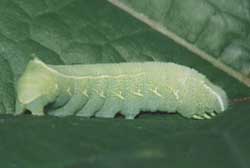 |
Darapsa myron, the Virginia Creeper Sphinx or the Grapevine Sphinx
If you have the
foodplants indicated in the common names, you probably have this
species nearby. The lower wings are orange.
Larvae feed on Virginia creeper (Parthenocissus quinquefolia),
Grape (Vitis), Ampelopsis, and Viburnum. |
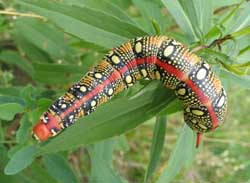 |
Hyles euphorbiae
introduced,
the Leafy Spurge Hawkmoth
This species has been introduced into Ontario to try to control
the spread of leafy spurge.
|
 |
Hyles gallii, the Bedstraw Hawk Moth
or Gallium Sphinx
This species is reported in Ontario.
Some years I see them on P.E.I., some years, I do not.
Larvae can be quite variable.
|
 |
Hyles lineata
BAMONA, the White-lined Sphinx
Larvae are highly varied and feed on a great diversity of plants
including willow weed (Epilobium), four o'clock (Mirabilis),
apple (Malus), evening primrose (Oenothera), elm
(Ulmus), grape (Vitis), tomato (Lycopersicon),
purslane (Portulaca), and Fuschia.
All larvae seem, however, to have the red/black swellings split by
dorso-lateral lines.
|
 |
This day flier is officially reported from Ontario, but it
maynot be common. Look for them in meadows near coniferous forests.
|
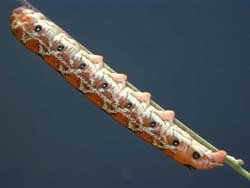 |
Newly-hatched caterpillars eat their eggshells. Larvae feed on
(Onagraceae) including evening primrose (Oenothera), gaura (Gaura),
and willow weed (Epilobium). Michael Van Buskirk has found them on
Guara biennis in Missouri. rare
|
|
|
